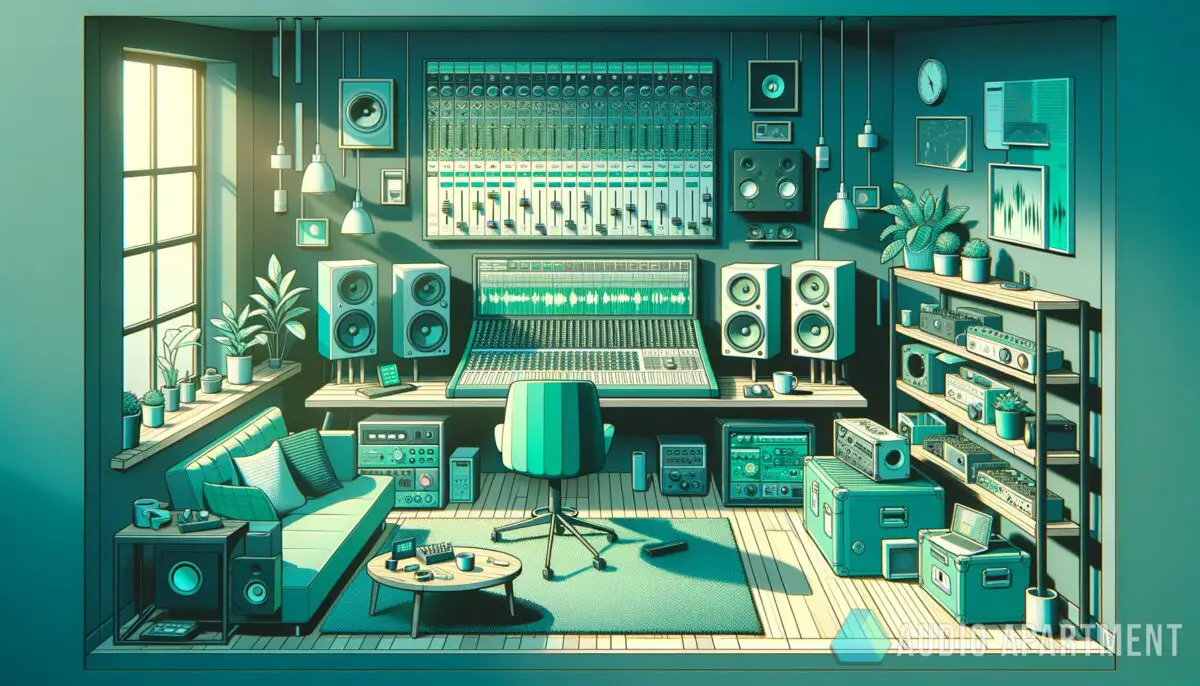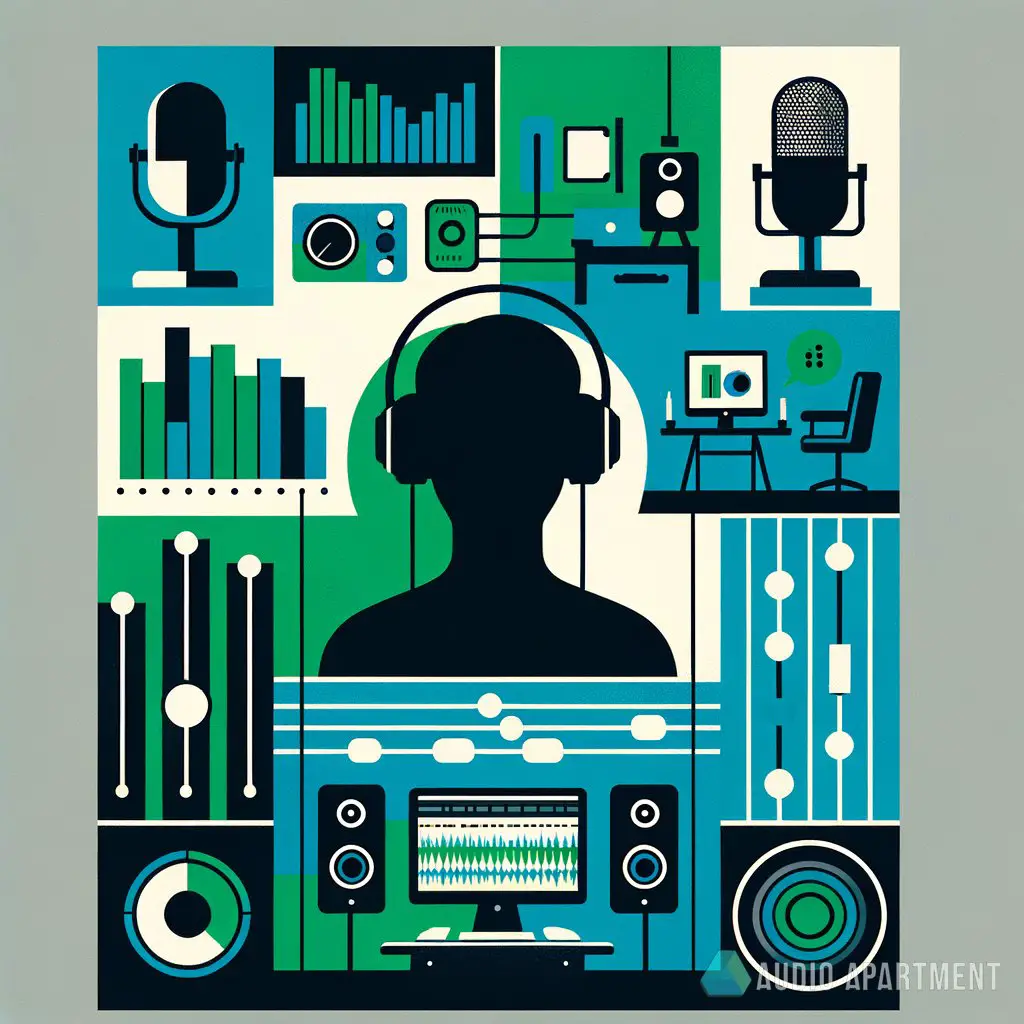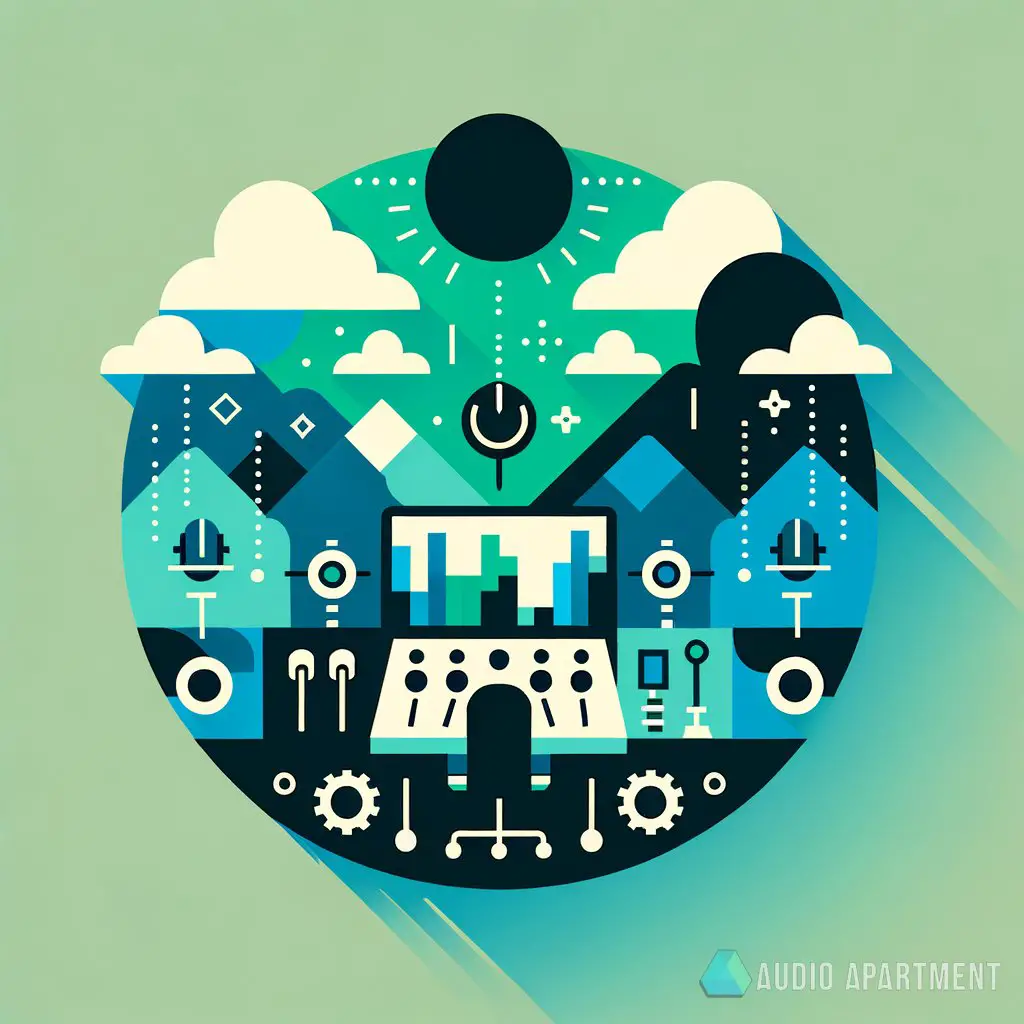In the bustling world of home studio production, knowing your mixing from your mashing is like telling apart a Gibson Les Paul from an air guitar. It’s essential, fam.
People get heated over this, trading barbs like “Compression is overused!” or “Man, Panning is underappreciated!” But if you’ve felt that tightness in your chest seeing a mixboard, wondering if you’re the only one sweating bullets over which knob does what, take a breath. We’ve hashed out the same debates in finding the right studio monitors.
What makes a home studio mix go from a garage band to Grammy vibes? Here, you’ll learn the key techniques to transform your raw tracks into polished gems.
Key takeaways
- Monitor selection is crucial in ensuring your mixes translate well across different listening environments.
- Optimizing room acoustics and speaker placement can significantly enhance your mixing experience.
- Software plugins can rival hardware, allowing professional mixing at home.
- Continuous learning from resources and communities is key to evolving your mixing abilities.
What Are the Essential Audio Mixing Techniques for Home Studios?
Mixing audio isn’t just about cranking up the volume faders and calling it a day; it’s a craft, a crucial part of the music production cocktail that can either make or break your track. So pour yourself a metaphorical glass and let’s distill the essential techniques down to their core:

- Balancing Levels: The highball of mixing, if you will. It’s all about getting the volume of each track just right, so they complement each other without any ingredient overpowering the mix.
- Panorama Placement: You’ll want to be meticulous about where each sound sits in the stereo field. Think of it as placing guests on the sound stage of your track — everyone should have a comfortable spot.
And here’s the kicker: Effects and dynamics processing, like:
- Equalization (EQ): Carving out sonic space for each instrument.
- Compression: Controlling the dynamic range to ensure nothing spikes harder than a bartender slamming down a tip jar.
Peep at resources like these on how to choose the most compatible DAW to get your mix on track.
Lemme give you the skinny; I’m no Clive Davis, but I’ve got some thoughts on mixing down stashed in my home studio dome. First off, mixing is more than twiddling knobs and hoping for the best — it’s like bartending for your ears.
You mix, you taste, and you mix some more until the sound is just right.
Now, let me tell you, I heard this banger of a story about “The Beatles” recording sessions. They were known for their revolutionary use of stereo panning and effects that became hallmarks of their sound.
“Mixing audio isn’t just about cranking up the volume faders and calling it a day; it’s a craft, a crucial part of the music production cocktail. It’s like bartending for your ears: you mix, you taste, and you mix some more until the sound is just right.”
Think about “Here Comes the Sun” — a mix that flows smoother than a top-shelf whiskey. Ringo’s delicate shimmers on the hi-hat panned just right, creating that spread-out, sunny soundscape.
That’s the essence of mixing; knowing just where to place each sound for that perfect blend. Dive into the details with these choice studio monitors for your home studio setup.
AKAI Professional MPK Mini MK3

AKAI Professional MPK Mini MK3
Creating the perfect home studio environment
When you’re laying down tracks in your bedroom, you can’t neglect the vibe of your space. We’re talking about room size, shape, and what’s on the walls.
These details affect how sound waves bounce around, which means they’re massive players in the quality of your mix. Check it out:
Room acoustics optimization
Your room can be your best bud or your worst enemy when mixing. Square or cubic rooms are a no-go—they’re acoustic nightmares.

Get your space decked out with:
- Bass traps for those pesky low-frequency waves
- Diffusers to scatter the sound evenly
- Acoustic foam panels to keep those reflections in check
Get more on how to handle your setup like a pro with these tips for enhancing your studio environment.
Speaker placement strategy
Getting your monitors in the sweet spot is crucial. It’s like positioning the DJ booth—do it right, and the party pops; do it wrong, and it’s a vibe killer.
So here’s the deal:
- Set up an equilateral triangle with your speakers and your seat
- Keep ‘em at ear level
- Angle your speakers inward
Dive deeper into the craft of setting up your studio with this guide to optimal speaker placement.
Soundproofing 101
Minimizing noise pollution is key to keeping your mixes clean. You don’t want that garbage truck outside to drop a guest verse on your track, right?
Use:
- MLV or resilient channel systems to mute that buzz from next door
- Door sweeps to seal your fortress of sound
For more hacks, peep these soundproofing materials and techniques.
Mixing software mastery
Now that you’ve nailed the set-up, let’s talk about the tools of the trade. Your DAW is like your guitar pick—it needs to feel right for you to shred.
DAW essentials
Choosing the right DAW is a make-or-break move for your production flow. You’ve got options like:
- Ableton Live with its wicked Session View
- Pro Tools and its beastly Audio Engine
- Logic Pro, Mac’s pride with extensive MIDI editing
Get the lowdown on the pros and cons of different DAWs and how they can elevate your home studio game in this detailed software selection guide.
Dialing in EQ and compression
Two words: Tone shaping. EQ and compression are your palette and brush in the art of mixing.
- Cut the mud with subtractive EQ
- Use compression to even out dynamic peaks and valleys
Sharpen your EQ and compression skills with these top-notch plugins and hardware.
Learning from the mixing gurus
The quickest path to levelling up your mix game? Stand on the shoulders of giants.
Let’s break it down.
Online resources and tutorials
YouTube’s your buddy here, with killer channels dishing out free wisdom. Then there’s:
- Podcasts spilling the secrets of sound gurus
- Blogs delivering bite-sized mixing lessons
Fuel your mix education by checking out these essential online resources and mixing tutorials.

Community building and networking
No one’s an island—especially in the music biz. Get in on:
- Gear forums where magicians exchange their spells
- Professional communities for that extra edge
State-of-the-art community forums can connect you with others looking to master the mix.
The mixing battlefield is no joke—meanwhile, I’ve got you covered with the stats, quick guides, and hate-to-love it details. It’s a whirlwind tour, but we’ve built a solid foundation that even a New York skyscraper would envy.
Before breaking down into a data table, it’s essential to understand the impact audio devices and software can have on your mixing endeavors. Whether it’s the type of DAW you choose or the speakers that grace your studio, each element contributes significantly to the overall sound quality.
Let’s scrutinize the choices and see how they measure up in the context of a home studio.
| Audio Equipment | Model | Feature | Special Fee |
|---|---|---|---|
| Studio Monitors | Adam Audio A7X | ART tweeters | $130.00 |
| Studio Monitors | Yamaha HS8 | Flat frequency response | $130.00 |
| DAW | Ableton Live | Non-linear composing | – |
| DAW | Pro Tools | Advanced editing tools | – |
| DAW | Logic Pro | Smart Controls | – |
| Compression Plugin | FabFilter Pro-Q | – | – |
| EQ Plugin | Waves SSL G-Series EQ | – | – |
| Soundproofing Material | Acoustic foam panels | Absorbs mid/high-frequency reflections | – |
Mixing can feel like walking a tightrope between a banger track and a garbled mess. But, with the right moves, you’ll be dropping mixes that slap harder than a meme on social media.
Remember, it’s not just the big things; the devil is in the details, people. Here’s a quick rundown of the dos and don’ts in the audio mixing realm.
| Do | Don’t |
|---|---|
| Balance levels to allow each track its moment | Overcompress signals into a lifeless sound |
| Use EQ to carve space for each instrument | Rely solely on presets without tweaking |
| Set up your speakers to form an equilateral triangle | Ignore room acoustics when placing your equipment |
| Learn from a variety of sources online and offline | Underestimate the power of critical listening |
| Utilize plugins and hardware that suit your style | Mix with soloed tracks only without context |
More mixing tips
Roll up your sleeves because we’re diving deeper into the mix! Just when you thought you had all the knobs and faders figured out, there’s more.
Here are some extra nuggets to keep in mind as you polish those tracks to perfection:
- Keep your initial levels conservative to prevent clipping and distortion.
- Avoid mixing at high volumes; instead, mix at moderate levels to ensure your tracks sound great at any volume.
- Tweak reverb and delay settings to add depth and space without muddying your mix.
- Automate volume and effects for dynamic changes and more professional sound.
- Continuously compare your mix to professional tracks to maintain perspective and quality control.
- Remember to take breaks for your ears to prevent fatigue and maintain critical listening.
- Update your plugins and DAW periodically to take advantage of new features and fixes.
If you are a visual learner, check out this video titled ‘BEGINNER HOME STUDIO SETUP (and why every musician needs one)’
Frequently asked questions (FAQ)
How important is monitor speaker choice in a home studio setup?
Choosing the right monitor speakers is essential because they directly influence how accurately you can hear and adjust your mixes. High-quality monitors will clearly reproduce sounds, allowing you to make informed decisions about EQ, compression, and other effects.
Can I get professional sounding mixes using only software plugins?
Yes, it’s entirely possible to achieve professional sounding mixes with software plugins. The quality of your mix depends more on your ears and understanding of mixing techniques than on using hardware.
However, adding hardware can add character and warmth to your mixes.
What is the role of room treatment, and can I mix without it?
Room treatment plays a significant role in minimizing unwanted reflections and standing waves, which can color your perception of the mix. While it is possible to mix without treating your room, untreated spaces can lead to less accurate mixes that may not translate well to other listening environments.
Final thoughts
All right, mixmasters, we’ve covered a lot of ground—from essential mixing techniques and the best gear for your home studio, to learning from the pros and keeping your skills sharp. Whether you’re just starting out or looking to refine your sound, remember that mixing is an art.
With practice and patience, your home studio mixes can absolutely reach new heights in audio engineering. So take these tips, turn up your favorite tracks, and start experimenting.
The mix revolution is just a plug-in away!
What’s been your biggest mixing challenge or success story in your home studio? Did I cover everything you wanted to know? Let me know in the comments section below I read and reply to every comment. If you found this article helpful, share it with a friend, and check out my full blog for more tips and tricks on the essential audio mixing techniques for home studios.
Thanks for reading, and keep those mixes fresh!















